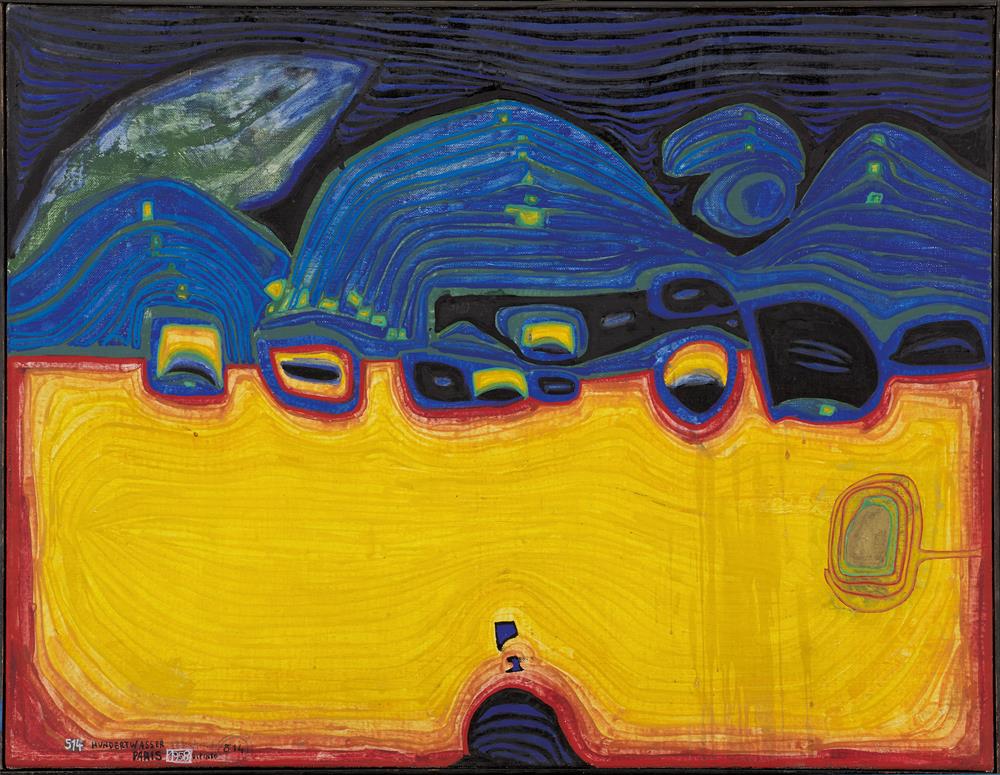
Vienna 1928 - 2000 Aboard the Queen Elizabeth II
Quiet in Tibet
Egg tempera and watercolour on wrapping paper primed with chalk and PV, mounted on canvas with PV
50 x 65 cm
Numbered, signed and titled: 514 HUNDERTWASSER 1970 [...] 514 / PARIS 1958 DIPINTO
Gallery label and stamp on the frame on the reverse: Galleria Levi / Milano
Exhibition label on the reverse: Studio d'Arte Contemporanea / Roma
Numbered and dated on the reverse: 514 1958 [...] 1970
Signed, inscribed and titled: HUNDERTWASSER 15P = 65 x 50 cm / SUR PAPIER / TIBET / TIBETRUHE / PAIX AU TIBET
Handwritten label on the reverse: 514 "Tibetruhe" / "Peace in Tibet" / HUNDERTWASSER 1958 PARIS / Restored 1970 MARCH / ROMA / TECHNICQUE MIXTE: EGG-WATER-COLOUR ON CHALK-GROUND ON PAPER GLUED ON LINEN WITH POLIVENIL / 50 x 65 cm = 15 P / ATTENTION: WHENEVER THIS PAINTING- / CHANGES HANDS, THE AUTHOR / MR. HUNDERTWASSER MUST BE / INFORMED OF THE NAME AND THE ADRESS OF THE NEW PROPRIETOR / Hundertwasser / Roma 5. MARZO 1970 / HUNDERTWASSER / GUIDECCA 43 VENEZIA
Fürst WV no. 514
Provenienz:
Galerie H Kamer, Paris
Claudio Bruni Collection, Rome, 1970
Mr. Trappani Collection, Venice
Galleria Internazionale, Milan
Antonio Boschi Collection, Milan
Galleria Levi, Milan
Galleria La Medusa, Rome
Agenzia d’Arte Moderna, Rome
Acquired from the above by the present owner in 1979
Ausstellungen:
Hanover, Kestner-Gesellschaft, Hundertwasser, 1964, p. 173
Rome, Galleria d’Arte / Istituto Austriaco di Cultura,
Hundertwasser, 1970, cat. 28
Alençon, Musée des Beaux-Arts e de la Dentelle, Hommage à
Hundertwasser 1928-2000, 2001, p. 41
Literatur:
Exhibition catalogue „Hundertwasser. Vollständiger Œuvre-Katalog mit 100 farbigen Reproduktionen“, ed. by Kestner-Gesellschaft, Hanover 1964, p. 173, no. 514
Andrea Christa Fürst, Hundertwasser 1928-2000, Catalogue Raisonné,
Cologne 2002, Vol. II, ill. p. 431, no. 514
Gisela Rosemann, Sprich ein deutliches Ja, 33 Bausteine für die Firmkatechese, Donauwörth 2003, ill. p. 48
Friedensreich Hundertwasser’s work ‘Quiet in Tibet’ was created in 1958. The title contrasts with actual developments in Central Asia, where at the time – with China’s invasion, Tibet’s declaration as an integral part of the People’s Republic, and just one year before the uprising for the Dalai Lama – the situation is highly tense. In far-off ‘La Picaudière’, the farmhouse idyllically located in the middle of fields and meadows, Hundertwasser created a peaceful, tranquil, fully harmonious and powerfully colourful picture in glowing egg tempera and watercolours, applied next to each without mixing and effectively accentuated by means of pitch-black. As a careful observer of global events and an active critic of civilisation, he was in no way denying current events with his title. Bearing no direct relation to the content, the title names always refer rather to the artist’s thoughts and feelings while painting. They visualise sounds or noises in untranslatable ‘word painting’ or relate to the places they were created in, too: ‘When I paint, I dream as well, after all. It’s like, if the dream comes to an end, I no longer recall what I dreamed, yet the picture remains. It’s the result of the dream, but I can no longer discover the origin of the dream. So, if the painter is no longer completely amazed by what he paints, then it’s not a good picture, for I would like to be surprised myself by my own pictures. I would want continually to discover my own paintings. In this way, I disconnect my personality, it comes from somewhere completely different, i.e. I switch off my intellect in order to let something have effect, that comes from far away, far, far away.’1
Hundertwasser’s works rather illustrate longing and at the same are evidence of a fulfilled life: ‘I have a strong feeling for how life should be and how paradise should be. I would rather sit in a chair and contemplate paradise, but as it does not want to form itself, I have to do it myself, unfortunately.’2 Hundertwasser reworked the watercolour in 1970, since when it has been found in renowned international collections and has been exhibited in selected museums, most recently in the Musée des Beaux-Arts et de la Dentelle in Alençon, close to where it was created.
1 Hundertwasser in: ‘Hundertwassers Regentag’, from: list of dialogue for ‘Hundertwassers Regentag’ by Peter Schamoni, 1973; quoted from: Exhibition catalogue ‘Hundertwasser. Die Kunst des grünen Wegs’, Kunsthaus Wien, 2011, p. 138
2 Hundertwasser in: ‘Nacktrede für das Anrecht auf die Dritte Haut’, held as the first speech by Hunderwasser whilst naked on 12 December 1967 in Galerie Hartmann, Munich; quoted from: Exhibition catalogue ‘Hundertwasser. Die Kunst des grünen Wegs’, Kunsthaus Wien, 2011, p. 130
